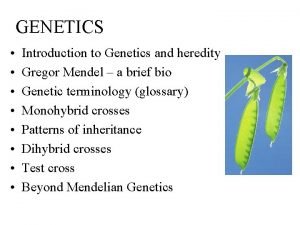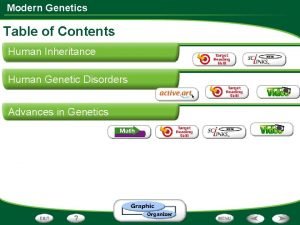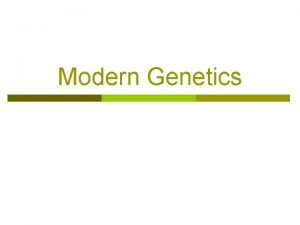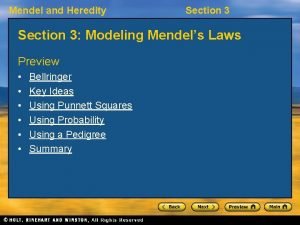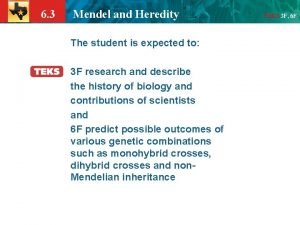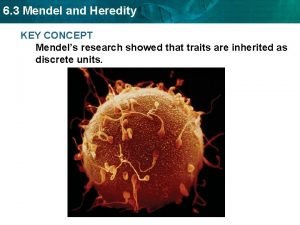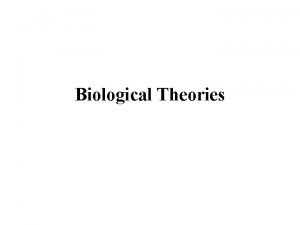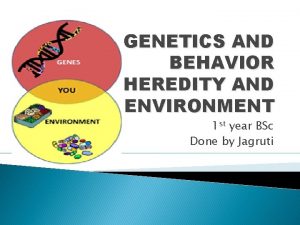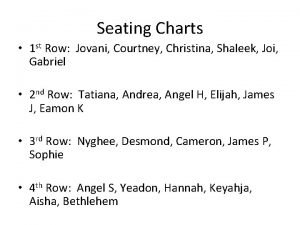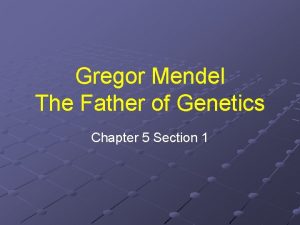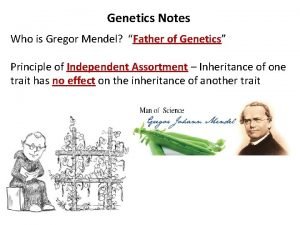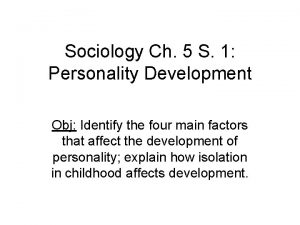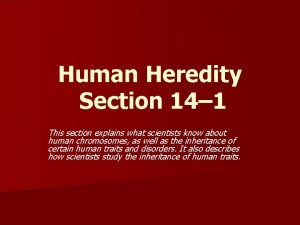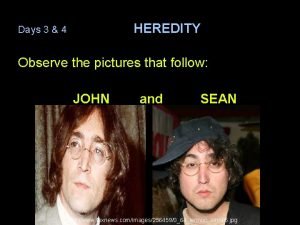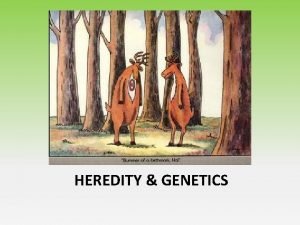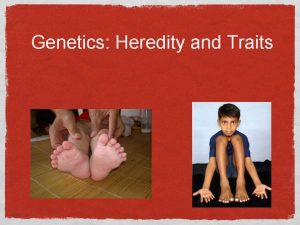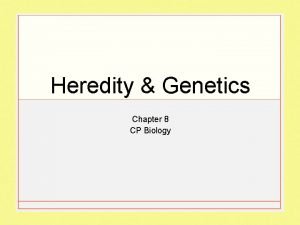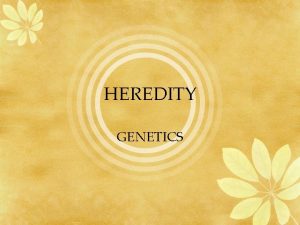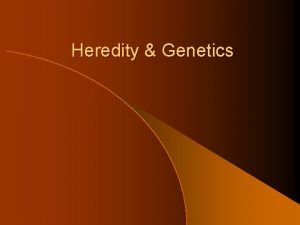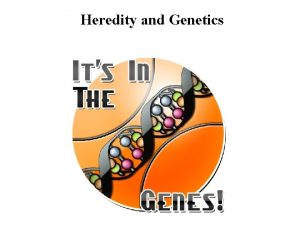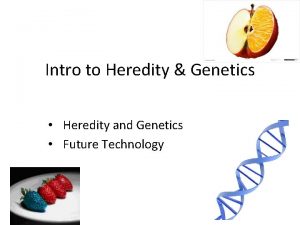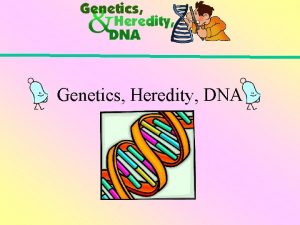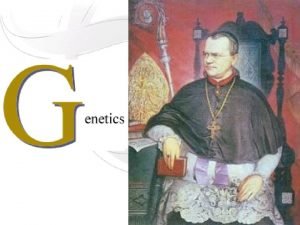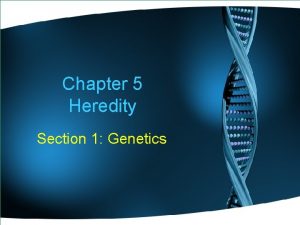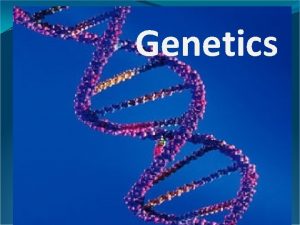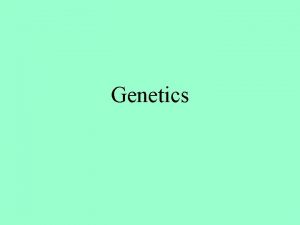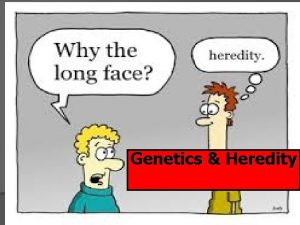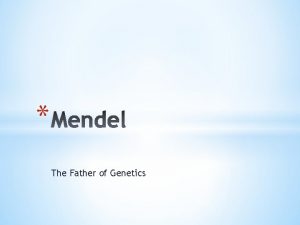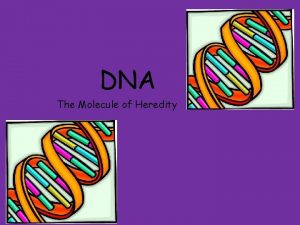GENETICS Inheritance and HEREDITY Genetics Father of Genetics





























- Slides: 29

GENETICS Inheritance and HEREDITY = Genetics

Father of Genetics: Gregor Mendel Austrian Monk � Grew Peas and studied their characteristics and their traits �Flower color: characteristic (gene) �Pink or white: Trait (allele)

� Mendel’s Work: Reasons for Studying Peas �Easily distinguished traits �Fast reproduction �Self pollinate: develop true breeding varieties parents and offspring have the same characteristics from generation to generation

Two types of Studies: � Monohybrid – study of one gene � Dihybrid – study of two genes Mendel Crossed Two types of Organisms: �Pure bred = Homozygous - two of the same allele �Hybrid = Heterozygous - two different alleles - typically one dominant and one recessive

Results of Mendel’s Work � Law of Dominance: Tall pure bred X Short pure bred � found all F 1 were Tall � one trait would over shadow the other trait � Against the convention of the time – blending

� Law of Segregation: � Took F 1 Generation and did a self cross Tall F 1 X Tall F 1 �found 75% of F 2 were Tall and 25% of F 2 were short � traits were preserved from one generation to the next and separated from one another during gamete formation

Law of Segregation

Mendel’s Crosses: How to do genetics Problems Homozygous Tall Pea plant X Homozygous Short Pea plant STEP 1: Make a Key: T = tall t = short • one letter for each trait • capital letters for dominant trait • lower case letters for recessive traits

� STEP 2: Write the genotypes of the parents Homozygous Tall = TT Homozygous Short = tt TT X tt

� STEP 3: Determine the possible gametes formed TT T or T tt t or t

� STEP 4: Draw a Punnett square and fill in the combinations

� STEP 5: Write the genotypic and phenotypic ratios ○ in a monohybrid cross, the ratios should add up to four ○ in a dihybrid cross, ratios should add up to sixteen

MONOHYBRID CROSS: the Punnett square P generation: TT x tt Male Genotype Female Genotype Possible Gametes

Male Genotype TT Possible Gametes Female Genotype T tt Possible t Gametes t T

Male Genotype TT Possible Gametes Female Genotype T tt Possible t Gametes t T

Male Genotype TT Possible Gametes Female Genotype T tt Possible t Gametes t Genotypic Ratio: Phenotypic Ratio: Tt Tt Tt

Male Genotype TT Possible Gametes Female Genotype T tt Possible t Gametes t Tt Tt Genotypic Ratio: 4: 0 Phenotypic Ratio: 4: 0 T Tt Tt

F 1 Generation Cross: Tt X Tt Male Genotype Female Genotype Possible Gametes

F 1 Generation Cross: Tt X Tt Male Genotype Tt Possible Gametes Female Genotype T Tt Possible Gametes T t t

F 1 Generation Cross: Tt X Tt Male Genotype Tt Possible Gametes Female Genotype T Tt Possible Gametes T t TT Tt Genotypic Ratio: Phenotypic Ratio: t Tt tt

F 1 Generation Cross: Tt X Tt Male Genotype Tt Possible Gametes Female Genotype T Tt Possible Gametes T t t TT Tt Tt tt Genotypic Ratio: 1: 2: 1 Phenotypic Ratio: 3: 1

Example Problems �A purple flowered pea plant that is the result of a cross between a purple flowered plant and a white flowered plant is crossed with a white flowered plant. How many of the offspring of this cross will be white and how many will be purple?

� In a certain species of fish blue scales is dominant over red scales. If two blue scaled fish mate and produce, 80 blue scaled offspring and 20 red scaled offspring, what are the genotypes of the parents?

�A new species of bird was recently discovered that shows two varieties of color, yellow and orange. When two orange birds are crossed, only orange offspring are produced. When two yellow are crossed, the results are either all yellow or yellow and orange. What does this tell you about the pattern of inheritance?

Test Cross T___ X tt � crossing of a dominant phenotype with an unknown genotype with a homozygous recessive

Possible Outcomes T ___ t t If some of the offspring show the recessive trait =

Possible Outcomes T t t Tt Tt t Must be recessive if tt appears tt tt If some of the offspring show the recessive trait = the unknown genotype has to be recessive

Possible Outcomes T t t __ Tt Tt If no offspring show the recessive =

Possible Outcomes T t t Tt Tt Tt If no offspring show the recessive = it is most likely that the unknown genotype is homozygous dominant depends on the number of offspring produced
 Chapter 11 complex inheritance and human heredity test
Chapter 11 complex inheritance and human heredity test Homozygous
Homozygous Intermediate inheritance
Intermediate inheritance Chapter 17 lesson 2 heredity and genetics
Chapter 17 lesson 2 heredity and genetics Human inheritance modern genetics answer key
Human inheritance modern genetics answer key Human clone
Human clone Modern genetics human inheritance answer key
Modern genetics human inheritance answer key Section 3 mendel and heredity
Section 3 mendel and heredity Chromosome
Chromosome Role of heredity
Role of heredity Section 3 mendel and heredity
Section 3 mendel and heredity Mendel 9 3 3 1
Mendel 9 3 3 1 Section 3 mendel and heredity
Section 3 mendel and heredity Section 3 mendel and heredity
Section 3 mendel and heredity Heredity and crime
Heredity and crime Heredity
Heredity Flocabulary genes and heredity answer key
Flocabulary genes and heredity answer key Gregor mendel father of genetics
Gregor mendel father of genetics Is o blood type recessive
Is o blood type recessive Father of genetics
Father of genetics Who is the father of genetics
Who is the father of genetics Who is the father of genetics?
Who is the father of genetics? Forkline method
Forkline method Genetic vocabulary worksheet answer key
Genetic vocabulary worksheet answer key An unchanging, biologically inherited behavior pattern.
An unchanging, biologically inherited behavior pattern. Mendelian genetics concept map
Mendelian genetics concept map 14-1 human heredity
14-1 human heredity Heredity defines the passage of genetic material from –
Heredity defines the passage of genetic material from – Pictures of heredity
Pictures of heredity Allele
Allele

